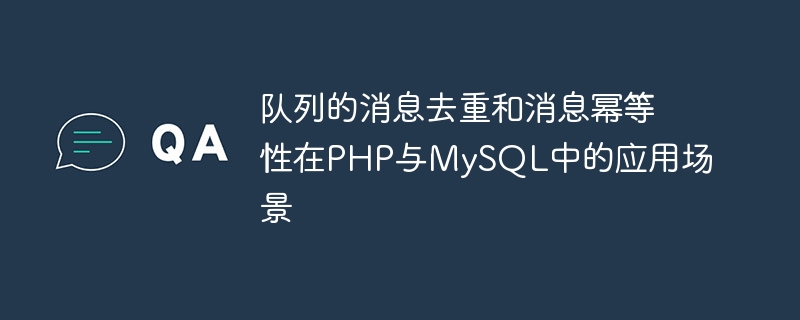Home >Backend Development >PHP Tutorial >Application scenarios of queue message deduplication and message idempotence in PHP and MySQL
Application scenarios of queue message deduplication and message idempotence in PHP and MySQL
- WBOYWBOYWBOYWBOYWBOYWBOYWBOYWBOYWBOYWBOYWBOYWBOYWBOriginal
- 2023-10-15 12:06:121504browse

Application scenarios of queue message deduplication and message idempotence in PHP and MySQL
Introduction:
With the continuous development of Internet technology, queues It has become one of the important basic components in various distributed systems. In the application process of queues, message deduplication and message idempotence are two common problems, especially in high concurrency scenarios. This article will introduce in detail the application scenarios of queue message deduplication and message idempotence in PHP and MySQL, and provide specific code examples.
1. Overview of message deduplication in queues
Message deduplication means that in the queue system, the same message can only be processed once to avoid repeated processing. For queuing systems, messages are often inevitably sent repeatedly. For example, network abnormalities, retry mechanisms and other factors may cause message duplication. Therefore, we need to perform message deduplication processing on the consumer side.
1.1 Deduplication methods
There are two common message deduplication methods: Redis-based deduplication and database-based deduplication. Redis-based deduplication is implemented through a collection data structure. Each time a message is consumed, Redis first queries whether the message has been processed. If it has been processed, skip it. Otherwise, the corresponding business logic is executed and the message is added to the Redis collection. middle. Database-based deduplication is achieved by establishing a unique index in the database. Each time a message is consumed, the database is first queried to see if a record of the message already exists. If it exists, it is skipped. Otherwise, the corresponding business logic is executed and Insert message records into the database.
1.2 PHP code example
Assume we use Redis as the storage medium for message deduplication. The following is a sample code:
<?php
$redis = new Redis();
$redis->connect('127.0.0.1', 6379);
// 判断消息是否已经处理过
function isMessageProcessed($message)
{
global $redis;
return $redis->sIsMember('processed_messages', $message);
}
// 处理消息并进行去重操作
function processMessage($message)
{
global $redis;
if (!isMessageProcessed($message)) {
// 执行业务逻辑
// ...
// 将消息加入到已处理消息集合中
$redis->sAdd('processed_messages', $message);
}
}
// 消费消息
function consumeMessage($message)
{
processMessage($message);
}
$message = 'example_message';
consumeMessage($message);2. Overview of queue message idempotence
The idempotence of messages means that the same message is processed multiple times, and the final processing result remains consistent. The idempotence of messages is very important in distributed systems, because in high concurrency situations, the same message may be processed by multiple consumers at the same time. If there is no idempotence guarantee, data inconsistency will occur.
2.1 How to implement idempotence
There are three common ways to implement idempotence: serial number idempotent table, idempotent custom annotation, and unique constraint. Among them, the sequence number idempotent table is created by creating an idempotent table in the database. Before processing the message, first query the idempotent table to determine whether the message has been processed. If it has been processed, skip it, otherwise execute the corresponding business logic. And insert the message record into the idempotent table. Idempotent custom annotations identify idempotent operations through custom annotations. Before the method is executed, it is first determined whether the method has been executed. If it has been executed, it will be skipped. Otherwise, the corresponding business logic will be executed. The unique constraint is achieved by establishing a unique index in the database. When duplicate records are generated during message processing, the database will automatically filter out the duplicate records.
2.2 MySQL code example
The following is a code example that uses MySQL to achieve message idempotence:
<?php
$pdo = new PDO('mysql:host=localhost;dbname=test', 'root', 'password');
// 判断消息是否已经处理过
function isMessageProcessed($message)
{
global $pdo;
$stmt = $pdo->prepare('SELECT COUNT(*) FROM processed_messages WHERE message = :message');
$stmt->execute([':message' => $message]);
return $stmt->fetchColumn() > 0;
}
// 处理消息并实现幂等性
function processMessage($message)
{
global $pdo;
if (!isMessageProcessed($message)) {
// 执行业务逻辑
// ...
// 插入处理过的消息记录
$stmt = $pdo->prepare('INSERT INTO processed_messages (message) VALUES (:message)');
$stmt->execute([':message' => $message]);
}
}
// 消费消息
function consumeMessage($message)
{
processMessage($message);
}
$message = 'example_message';
consumeMessage($message);Conclusion:
In queue applications, message deduplication and Message idempotence are two very important issues. Through the specific code examples based on Redis and MySQL introduced in this article, the problem of repeated message processing and data consistency can be effectively solved, and the reliability and stability of the system can be improved. In practical applications, it is necessary to select appropriate deduplication and idempotence solutions based on specific business scenarios, and perform corresponding tuning and optimization as needed.
The above is the detailed content of Application scenarios of queue message deduplication and message idempotence in PHP and MySQL. For more information, please follow other related articles on the PHP Chinese website!

